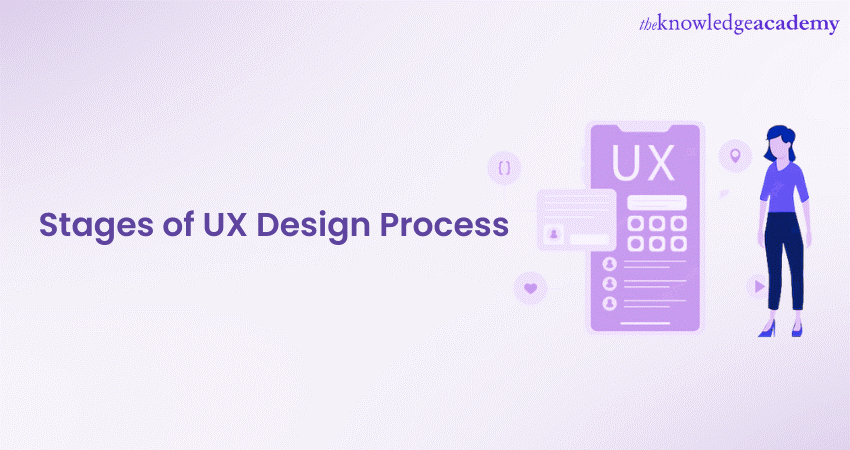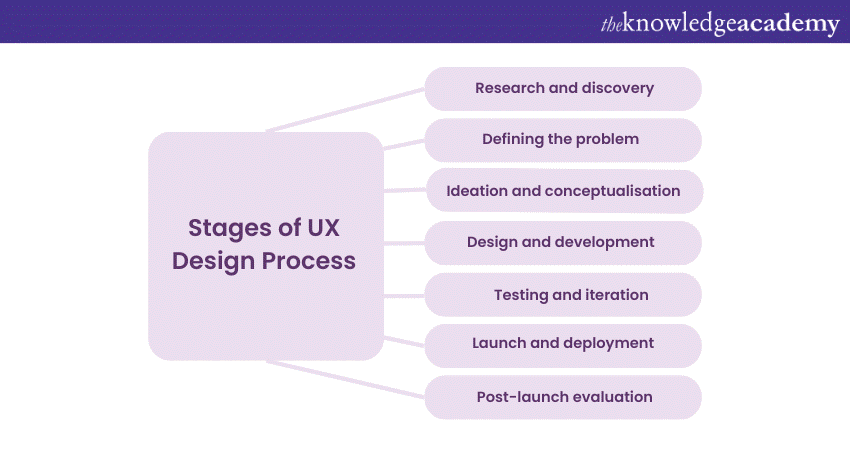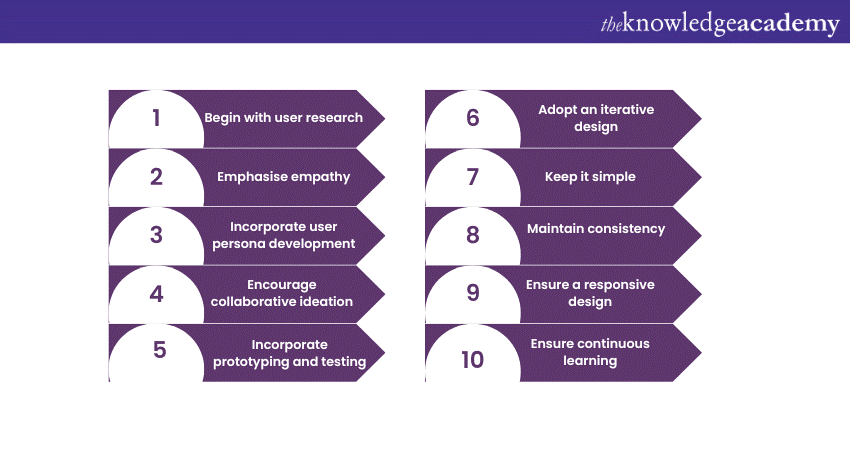We may not have the course you’re looking for. If you enquire or give us a call on 01344203999 and speak to our training experts, we may still be able to help with your training requirements.
Training Outcomes Within Your Budget!
We ensure quality, budget-alignment, and timely delivery by our expert instructors.

User Experience (UX) Design is a very essential aspect of creating successful products and services in the modern digital world. It involves understanding the needs, preferences, and behaviours of users to create intuitive, user-friendly, and delightful experiences. In this blog, we will explore the different Stages of UX Design Process and understand how each step contributes to crafting exceptional User Experiences.
Table of Contents
1) What are the stages of UX Design Process?
a) Research and discovery
b) Defining the problem
c) Ideation and conceptualisation
d) Design and development
e) Testing and iteration
f) Launch and development
g) Post-launch evaluation
2) Best practices for UX Design Process
3) Conclusion
What are the stages of UX Design Process?
Before we delve into the Stages of UX Design Process, we will first define what is UX Design Process. The UX Design Process is a structured and iterative approach to creating user-friendly and enjoyable products and services. The process places the user at the core, focusing on empathy, simplicity, and responsiveness to deliver exceptional user experiences. The following are the different stages of the process:

Research and discovery
The first stage of the UX Design Process is research and discovery, and it serves as the foundation for creating meaningful and impactful User Experiences. In this phase, Designers dive deep into understanding the target audience, their behaviours, preferences, and pain points. User research methodologies such as interviews, surveys, and usability tests are employed to gain valuable insights. These insights help in creating accurate user personas, which represent different user segments and their motivations.
Apart from understanding users, this stage also involves market analysis to identify the competitive landscape and industry trends. By exploring competitor products and services, Designers can find opportunities and gaps in the market that can be leveraged to ensure a unique and successful User Experience.
User journey mapping is another critical aspect of research and discovery. It allows Designers to visualise the entire User Experience, from the initial interaction to the final goal. This mapping helps identify pain points and areas for improvement, ensuring a seamless and intuitive user flow. Through thorough research and discovery, Designers gain empathy for users, understand the context in which the product will be used, and set a strong foundation for the subsequent stages of the UX Design Process.
Defining the problem
Once the research is complete, the next stage involves defining the problem that the UX Design needs to address. This step is crucial as it ensures that the design efforts are focused and aligned with the needs of the users and the business objectives.
A clear problem statement is crafted, highlighting the main challenge or pain point that the product or service aims to solve. This statement serves as a guiding compass throughout the process, keeping the team on track and preventing scope creep.
To create an effective problem statement, Designers revisit the insights gathered during the research phase. By identifying common themes and patterns in user feedback, they can articulate the problem in a way that resonates with the target audience.
Moreover, defining the problem involves summarising user needs and goals. Understanding what users want to achieve helps in prioritising features and functionalities that align with their expectations. Additionally, setting measurable objectives ensures that the success of the design can be evaluated objectively. A well-defined problem sets the stage for successful ideation and concept development, where Designers can explore various solutions to address the identified challenges.
Unlock your creative potential and master UX/UI Design with our comprehensive UX / UI Design Jumpstart Training – join now and jumpstart your career!
Ideation and conceptualisation
The ideation and conceptualisation stage is where creativity takes the centre stage. Building upon the insights gathered from the research phase and the problem statement, Designers engage in brainstorming sessions to come up with a wide range of ideas and potential solutions.
During these collaborative sessions, no idea is considered too wild or too mundane. The goal is to explore as many possibilities as possible without any constraints, encouraging out-of-the-box thinking. Diverse perspectives from different team members can lead to innovative and unexpected solutions.
To visualise these ideas, Designers create low-fidelity sketches and wireframes. These rough representations provide a visual structure of the potential designs without getting into the finer details. With low-fidelity prototypes, Designers can quickly iterate and refine the concepts.
Another critical aspect of ideation is prototyping. By creating interactive prototypes, Designers can simulate the User Experience and test how users interact with the proposed solutions. Prototypes allow for early validation and help in identifying usability issues and pain points. The ideation and conceptualisation stage is a dynamic process that leads to the development of promising design directions, setting the stage for the next phase of design and development.
Design and development
The design and development stage marks the transformation of ideas into tangible products. It is where the chosen concepts from the ideation phase start to take shape, and Designers delve into the finer details of the user interface and interaction design.
High-fidelity wireframes are created, adding more detail and visual aesthetics to the designs. The visual design incorporates colours, typography, icons, and imagery that resonate with the brand and appeal to the target audience. Interaction design becomes crucial during this stage. Designers define how users will navigate through the product and interact with various elements. Micro-interactions, animations, and transitions are implemented to enhance the User Experience and add a touch of delight.
Moreover, front-end development brings the design to life by building the actual User Interface (UI) using HTML, CSS, and other web-based technologies. This stage involves close collaboration between Designers and developers to ensure that the vision is accurately translated into a functional product.
Throughout the design and development phase, Designers maintain a user-centric approach, making sure that every decision aligns with the user needs and goals. Regular user testing and feedback collection are integrated to iterate and refine the design, ensuring that the final product is optimised for an exceptional user experience.
Unlock the secrets of exceptional User Experiences - sign up for our User Experience (UX) Masterclass Course now!
Testing and iteration
Testing and iteration are iterative processes that run parallel to the design and development stage. It involves evaluating the product with real users and collecting feedback to identify any usability issues or areas for improvement.
Usability testing is a fundamental aspect of this stage, where users interact with the product under controlled conditions. Observing how users navigate through the product and complete tasks provides valuable insights into the User Experience. Feedback collection is essential for understanding user perspectives and pain points. Surveys, interviews, and feedback forms can be used to gather user opinions and thoughts on the product.
Based on the feedback and testing results, Designers make necessary changes and improvements to the design. Iterative design allows for continuous enhancements, ensuring that the product evolves to meet user expectations. By iteratively testing and refining the design, the final product is much more likely to offer a seamless and enjoyable experience.
Launch and deployment
The launch and deployment stage marks the culmination of the UX Design Process, where the final product is ready to be released. It is the stage where all the hard work and efforts come to fruition.
Before a full launch, some products undergo a soft launch, where they are released to a limited audience for further testing and feedback. This soft launch allows the team to identify any last-minute issues and make minor adjustments before the broader release.
The launch phase requires careful planning and coordination, involving various teams such as marketing, sales, and customer support. The marketing team creates strategies to promote the product and reach the target audience effectively. Customer support teams are prepared to handle user inquiries and troubleshoot any problems that users may encounter after the launch. Once the product is launched, the team closely monitors user feedback and engagement to ensure that the product meets expectations and performs optimally.
Post-launch evaluation
The UX Design Process doesn't end with the launch; in fact, it's an ongoing and iterative journey. Post-launch evaluation involves continuously monitoring and analysing the product's performance and user feedback to make data-driven decisions for improvement.
Performance monitoring is essential to gauge how well the product is performing against the objectives set in the earlier stages. Metrics like user engagement, conversion rates, and user retention are analysed to assess the product's success.
User support plays a crucial role during this stage. Responding promptly to user feedback, addressing any issues, and providing excellent customer support foster positive user experiences. Data-driven insights and user feedback inform subsequent design iterations, as the product evolves to meet changing user needs and market demands.
Want to unlock your potential in Mobile App Development? Join our Mobile App Development Training now!
Best practices for UX Design Process
Now that we know what is the UX Design Process and its stages, we will explore its best practices. User Experience (UX) Design is a field that requires a well-structured approach and adherence to best practices to create successful and meaningful User Experiences. Below are some essential best practices for the UX Design Process:

1) Begin with user research: Begin the UX Design Process with thorough user research. Understand your target audience's needs, preferences, pain points, and behaviours. Conduct user interviews, surveys, and usability tests to gather valuable insights. User research sets the foundation for user-centric design decisions.
2) Emphasise empathy: Develop empathy for your users to better understand their emotions and motivations. Putting yourself in the users' shoes allows you to design experiences that truly resonate with them and cater to their unique requirements.
3) Incorporate user persona development: Create user personas based on your research findings. User personas represent typical users with specific characteristics, goals, and pain points. They serve as reference points throughout the UX Design Process, keeping the team focused on the target audience.
4) Encourage collaborative ideation: Encourage collaborative brainstorming sessions to generate diverse ideas. Embrace a culture that values everyone's input and ensures that ideas are evaluated without judgment. Different perspectives can lead to innovative solutions.
5) Incorporate prototyping and testing: Use prototyping tools to create interactive prototypes and test your designs with real users. Rapid prototyping allows you to gather early feedback, validate design decisions, and identify usability issues before investing in development.
6) Adopt an iterative design: Adopt an iterative UX Design approach. Continuously refine your designs based on user feedback and insights. Iteration allows you to address issues and improve the user experience incrementally.
7) Keep it simple: Strive for simplicity in your designs. Avoid clutter and unnecessary complexity that might overwhelm users. Clear and intuitive designs lead to better usability and satisfaction.
8) Maintain consistency: Maintain consistency in your design elements such as typography, colours, and icons. Consistency creates a cohesive and familiar user experience, reducing cognitive load and enhancing learnability.
9) Ensure a responsive design: Ensure your UX Design is responsive and adaptable to various devices and screen sizes. A responsive UX Design provides a seamless experience for users across different platforms.
10) Ensure continuous learning: Stay up-to-date with the latest trends and technologies in the UX Design field. Attend industry conferences, read design blogs, and participate in workshops to enhance your skills and knowledge.
Conclusion
The UX Design Process is a dynamic and iterative journey focused on understanding users, defining problems, generating ideas, and creating delightful experiences. Upon following the Stages of UX Design Process, Designers can craft products and services that resonate with users and stand out in today's competitive landscape. You must remember that successful UX Design is a continuous process of improvement, learning, and adaptation to ever-evolving user needs.
Unlock your potential in App and Web Development with our expert App and Web Development Training Courses - sign up today!
Frequently Asked Questions
Upcoming Programming & DevOps Resources Batches & Dates
Date
 UI UX Design Course
UI UX Design Course
Mon 3rd Jun 2024
Mon 2nd Sep 2024
Mon 16th Dec 2024







 Top Rated Course
Top Rated Course



 If you wish to make any changes to your course, please
If you wish to make any changes to your course, please


